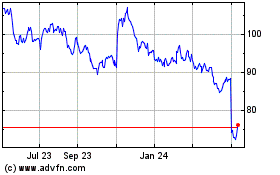By Costas Paris
PLAINVIEW, N.Y. -- It looks more like a warehouse than a Long
Island burger joint, but the Bareburger restaurant on a busy
intersection here is attracting patrons for its food -- and its
architecture.
The restaurant, which opened last year, is made of 11 truck-size
containers previously used by Japanese shipping company NYK Line.
Bareburger Group LLC worked with SG Blocks Inc., which specializes
in container-based buildings and has designed similar structures
for Starbucks Corp., Yum Brands Inc.'s Taco Bell restaurants and
Lacoste stores.
"It came naturally," says John Simeonidis Jr., Bareburger's
co-founder and chief design officer. "We use reclaimed wood for
floors and tables, recycled vinyl for seats and so on. So we said,
'let's think outside the box for the structure' and ended up
building a metal box that looks really cool."
Shipping containers, typically 20 or 40 feet long, are the
workhorses of freight transportation, used to move most of the
world's manufactured goods. Shipping companies pay about $2,000 to
$3,000 for each one, with an average container lasting 18 years
before it is retired from sea.
More of these used containers are finding second lives as
building materials, popping up in restaurant chains like Bareburger
as well as private homes, theme parks, swimming pools and prison
cells.
Although such structures are becoming more popular for their
trendy looks, they aren't about to replace traditional buildings,
construction executives say.
Containers must be cut when stacked to widen the living space or
to create windows and doors, and need to be insulated from the
inside and reinforced with steel beams in multistory structures.
And after they are put together, conversions or expansions are
difficult and expensive.
About 1 million containers a year are sold or leased for inland
use, shipping executives say. Maersk Line, a unit of Danish
conglomerate A.P. Moller Maersk A/S with 2.7 million containers in
use world-wide, sold 70,000 of them for $1,000 to $1,300 apiece
last year, said Rune Sorensen, the unit's head of container
sales.
That was double the amount it sold in 2015, he said, and he
expects the growth to continue in the coming years. The market, he
added, "is still discovering itself."
In Brooklyn's Williamsburg neighborhood, architecture studio
LOT-EK stacked 21 containers, then cut the structure diagonally to
create a three-story, 5,000-square-foot single-family home.
"It must be one of the most photographed houses in Brooklyn,"
says Simon Araya, who works at a nearby cafe. "In the beginning it
stood out like a sore thumb, but it does fit Williamsburg's hipster
and artistic culture."
LOT-EK has used containers on other projects, including Qiyun
Mountain Camp, a 60-acre extreme-sports park in Huangshan, China,
scheduled to open later this year, and a seven-story apartment
block in Johannesburg, South Africa, using 140 metal boxes. Slated
for completion this summer, it is expected to be the world's
biggest container structure.
Ada Tolia, one of LOT-EK's co-founders, described containers as
"the most prominent symbols of globalization, that move just about
everything we own on ships, trucks or trains."
Once they have been retired from their primary use, she said,
"they can be used as Lego blocks that can be stacked or shaped to
make the most efficient, lightweight and strong structures."
Elsewhere, their second lives are more mundane. New York
public-works contractors stack them up as temporary support for
overpasses, while Australia's Department of Correctional Services
uses them for prison cells. Containers also are used as temporary
structures in seasonal or remote locations by retailers, medical
clinics, energy workers and the military.
The United Nations uses containers in Haiti as a secure,
weather-resistant way of storing food, water, medicine and other
equipment.
"When Hurricane Matthew hit the island last October, it was
tremendously useful to have hurricane-response gear stored and
pre-positioned in shipping containers," said U.S. Air Force Maj.
Andrew J. Schrag, who participated in the U.N. peacekeeping
deployment. "Containers performed tremendously and enabled the
'Blue Helmets' to be much more effective in preventing a prolonged
human catastrophe in the aftermath of the hurricane."
Industry executives say building with containers can be 40%
faster and 20% cheaper than using traditional building materials,
though Bareburger ultimately paid double what it budgeted for the
Plainview restaurant. The project cost about $2 million and took
four years from conception to completion, with builders struggling
to work with the dented metal and inspectors conducting extensive
reviews before approving the construction.
"It was a massive learning curve," Mr. Simeonidis said. "It was
a new way of building that builders on site had no feel for."
Write to Costas Paris at costas.paris@wsj.com
(END) Dow Jones Newswires
May 15, 2017 05:44 ET (09:44 GMT)
Copyright (c) 2017 Dow Jones & Company, Inc.
Starbucks (NASDAQ:SBUX)
Historical Stock Chart
From Mar 2024 to Apr 2024

Starbucks (NASDAQ:SBUX)
Historical Stock Chart
From Apr 2023 to Apr 2024
